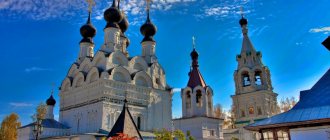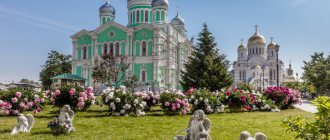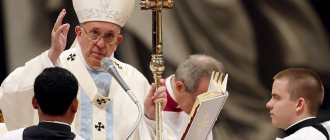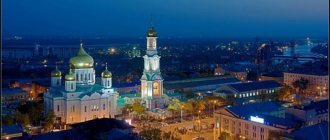About their morals
I have been interested in China since childhood. And one of the first people I had the privilege of baptizing after taking the priesthood was my Chinese neighbor. We met, talked a lot, barely speaking each other’s languages, and one day a neighbor said that he wanted to become Orthodox. Some time after my baptism, he invited me to go to China. And now I have been serving here in Hong Kong for 9 years...
Orthodox Chinese from Beijing, Harbin and Shanghai celebrated Easter with a secular service at the Catholic Cathedral of the Archangel Michael in the capital of the People's Republic of China. Photo from the site https://www.orthodox.cn.
It must be said that Russians have a much worse idea of China than the Chinese have of Russia. When we go to Beijing, we should not expect to see the times of Confucius or Lao Tzu. It's like going to New York and expecting to see virgin forests from the time the settlers from the Old World first met the Indians. Or go to Tokyo and, instead of skyscrapers, hope to see there the capital of the ancient Japanese emperors.
Hong Kong, Beijing, Shanghai - all these are colossal Western-style megacities, with high-rise buildings, highways and multi-level interchanges. This reflects the fact that the modern Chinese is a rather “Westernized” person and, moreover, I must especially emphasize, a person who is largely deprived of his traditional culture. Because in China there was not just communism, but a very tough totalitarian period, with the “cultural revolution”, forced secularization, and after that - the period of economic reforms by Deng Xiaoping.
Therefore, a modern resident of Beijing or Hong Kong is completely different from the Chinese imagined by the imagination of a Westerner fascinated by Asian antiquity. This does not mean that the Chinese lack national characteristics.
For example, it is obvious that this is a people not prone to envy, and a spirit of optimism is clearly felt in them, unlike us Russians - we always concentrate more on negative things and are always ready to consider the development of events according to a pessimistic scenario. To the lack of envy of the Chinese, add their goodwill: let's say, they have the belief that the good that someone did to you must be returned in abundance.
However, the Chinese are also characterized by very sharp emotional fluctuations. Suddenly you may encounter both vindictiveness and rancor. But, I repeat, envy is absolutely not inherent in them. Lack of envy is an absolutely wonderful trait that I notice in the Chinese and, unfortunately, I don’t see in Russians!
So it was not difficult for me to get along with the local population in Hong Kong - they are open to communication and, so to speak, reasonable and rational. And if in the Soviet period we were brought closer to the residents of the PRC by state ideology, then new times have brought us closer in a different way: through globalization and a world more or less striving for a common denominator of values. Although, of course, globalization also has a negative impact, erasing differences and destroying originality.
Church of Hagia Sophia
It so happened in Russian Orthodoxy that the first temple that was erected in a new city was named in honor of Hagia Sophia. St. Sophia Cathedral in Harbin for a long time remained a stronghold of Orthodoxy in Manchuria.
In the photo: construction of St. Sophia Cathedral in 1928
Built in the 20s of the twentieth century in the pseudo-Russian or, more precisely, Byzantine architectural style, St. Sophia Cathedral is today recognized as an architectural monument.
But the temple originally appeared on this site back in 1907. It was made of wood, but in 1911 it was surrounded by a brick wall, then it was completely rebuilt.
In the photo: Epiphany Church in St. Petersburg, which is one of the prototypes of the Harbin St. Sophia Cathedral
After the Russians left the city, the temple was closed and was often used for household needs. It was restored in the 1990s, and after renovation it houses a gallery of photographs telling the history of the city.
2
About the death... of Chinese culture
Everyone still expects some bright specifics from their acquaintance with China. But, probably, apart from some protected places in the country, the only original thing that you will encounter in everyday life is, perhaps, Chinese cuisine. As for the rest... The housing here is European, and so are the clothes. None of the Orthodox churches in China are built with elements of the Chinese style in architecture and interior. Our house church in Hong Kong is an office that we simply converted into a temple.
Even the icons where Christ and the saints are depicted with characteristic Chinese facial features are not local creativity, but attempts by Europeans to enter Chinese culture. And, from my point of view, this is a violation of one of the principles of iconography - the authenticity of what is depicted. This does not correspond to historical reality: Christ was not Chinese. For the people of China themselves, this is not an obstacle to accepting Christianity. 500-600 years ago, when the world was not yet globalized, it was a different matter. But today, I think, when Christ is painted on an icon in the canonical image - in the one in which He appeared - this is clear to everyone, it is enough just to add hieroglyphs and use national decor in moderation.
So, the influence of traditional Chinese culture, as we usually imagine it, is noticeably small. Moreover, not so long ago I heard a statement from a fairly well-known Beijing professor - he spoke in Russia - which shocked many Russians. He said: “Chinese culture is dead. And from the point of view of many scientists in China, the only thing that can resurrect it is an encounter with Christianity.” An unexpected look, even paradoxical! Moreover, although this is his private opinion, he is far from alone in his conviction. Although this point of view unexpectedly brings the West closer to the East, the process of dying of culture is happening everywhere.
There is interest in Christianity in China.
The fact is that Chinese society is now in a stage of serious transformation: the social, property structure, and political life are changing so rapidly that it feels unstable. People are looking for support. And in the course of this search, China, like Brazil or Japan, like a vacuum cleaner, sucks in everything from the outside: money, foreign technologies, ideas, thoughts, elements of worldview systems.
Since at one time a strong blow was dealt to the traditional Chinese worldview, in spiritual terms this appeal to the external, foreign is expressed in interest in Christianity.
Many believe that it is precisely this that can make up for some incompleteness or lack of self-sufficiency in modern Chinese society.
China has ceased to consider itself the center of the world (which the classical Chinese model of the world once spoke about and from which the country was at one time isolated and self-sufficient). Although one cannot deny a country the right to be called a great power, a country with enormous potential, China has now taken a more realistic position than before: it has ceased to be a supporter of self-isolation. The children of the Chinese political elite study in America or, at worst, in Switzerland or Britain. The Chinese look at other countries and peoples more soberly and realistically. An expression of this for me was the answers of some modern scholars to my question: “Where do you think is the best place to learn Chinese?” Do you know what they answered me? "In Oxford!" And it wasn't a joke.
Cathedral of the Sacred Heart of Jesus
In 1900, railway workers from Poland arrived to build the railway, and, naturally, the question arose about building a Catholic cathedral in the city.
In 1906, the first stone laid in the foundation of the new church was consecrated by the Catholic priest Dominik Przyluski, who arrived here. A year later, the Catholic church was built and became the co-cathedral Cathedral of the diocese of Heilongjiang Province.
During the Cultural Revolution, the diocese was abolished, and today the cathedral is under the jurisdiction of the apostolic administration.
3
About the language
Openness to the world and craving for Christianity are associated with one problem: it is difficult for the Chinese to understand what the difference is between Protestants and Catholics, on the one hand, and Orthodox Christians, on the other. They know more or less about Western Christianity here, but to clearly, competently, and in accessible language present the peculiarities of our religious teaching, the difference between Orthodoxy and Catholicism or Protestantism, is a serious task.
And here knowledge of the language plays a colossal role. This is the main tool of missionary work. Clear, competent, qualified, accurate translation into the local language - you can’t do anything without it!
Of course, there are not enough translators, because knowledge of spoken Chinese is catastrophically insufficient for such work. And an illiterately translated text is simply double sabotage. At the same time, it is difficult to use translations from the times before communism, when there was a more or less developed Russian Orthodox mission in China and various translations appeared - the language itself has changed quite a lot.
By the way, Catholics and Protestants help us publish books in Hong Kong: their publishing houses are ready to take some of our books, provided that we finance the publication, pay for the creation of the layout and share the hypothetically possible profit with them. Which, however, never existed. I think this cooperation is important. In addition, a dialogue about faith arises; they are also interested in Orthodoxy: among those baptized there are many people who came to the Church from the Western Christian tradition.
Zilesi Monastery
In 1920, this majestic Temple of Bliss or Supreme Joy was erected by Master Yanxu, and the temple complex became one of the four famous Buddhist temples in northern China.
The Buddhist temple consists of several majestic halls, and their facades face the Drum Tower Facade and the bell tower. The most beautiful decoration can be seen in the King's Hall, the Book Hall and the three Bodhisattva Halls.
Every April, a Buddhist festival is held here, which attracts Buddhists from China and neighboring countries.
5
About Chinese New Year
One of the most difficult questions among Chinese Christians is the attitude towards syncretism, the admissibility of participation in traditional rituals and holidays, which in some form have survived to our time. Some holidays have a fairly pronounced religious, pagan character, and here you need to understand where to draw the line between what is permissible and what is not.
For example, the Chinese New Year holiday does not have a pronounced religious connotation - it is associated with the change of seasons. Once upon a time in ancient times it was believed that at this time a certain spirit of the Nian New Year appears, and it must be appeased - by shooting firecrackers, for example. But now the New Year in China is just a family dinner, with virtually no rituals. Therefore, most Chinese Christians consider it acceptable to participate in it.
Or there's the Dragon Boat Festival. It is rather patriotic and consists of competitions with boats made in the shape of dragons and eating rice cakes wrapped in palm leaves - in memory of the poet who performed a civic heroic feat in his time. There's nothing wrong with that either.
And, say, the mid-autumn holiday is clearly pagan. It is based on the origins of the veneration of spirits associated with the moon, with the history of the mystical journey of a certain Chang E to this very moon. Therefore, worship of her spirit is performed there, lamps are lit in her memory. And so Chinese Catholics and Protestants refrain from participating in this holiday. Protestants are even more strict: I know those who do not celebrate the New Year, which goes against widely-rooted Chinese practice.
Harbin Cathedral Mosque
There is also a place in Harbin where every Muslim can praise Allah. The first mosque appeared on this site in 1897, but was destroyed.
In 1904 it was restored to its original form, and in 1935 a large stone mosque was erected with donations from believers. It was she who became the center of Islam in Northeast China.
The mosque was built in traditional Arabian style and covers an area of about 430 m². A real gem of Harbin with a library and beautiful wall paintings, it is protected by the state.
Our website most-beuty.ru has already written an article about the most beautiful mosques in the world, we recommend you take a look.
About the transition to Orthodoxy
Chinese interest in Orthodoxy largely exists among Catholics and Protestants. The mission is not limited to one or another category of people: if a Chinese, being a Catholic or Protestant, feels some kind of incompleteness in his faith, then why not tell him about Orthodoxy? They approach this consciously: they read a lot, learn, and ask. They have a desire for spiritual life in general. And in Orthodoxy they see some sufficient depth for spiritual life - the experience of prayer, the experience of monastic asceticism is very important for many.
In any case, the transition to Orthodoxy is a difficult step for them: these people leave Catholic and Protestant communities, losing the social circle to which they are accustomed, and find themselves practically alone. There are quite a lot of them, they are dispersed - two, three people in different cities. Sometimes they gather together and pray together, but it is difficult to call these meetings an organized community. This is a serious problem for them. This can be partly solved through communication on the Internet.
An ethnic Chinese in his own country can only be baptized into Orthodoxy illegally: there is simply no place where one could be baptized, because there are no Chinese clergy.
Regular services are held (only) on the territory of the Russian consulate, but Chinese citizens cannot come to worship there: Russian diplomats, at the request and insistence of the Chinese authorities, are not allowed into either the territory of the embassy in Beijing or the territory of the consulate in Shanghai.
You can be baptized unofficially, which happens from time to time: for example, priests from Siberia came to Xinjiang and quietly and secretly baptized a dozen and a half people from villages in the rivers of Xinjiang. Or another option: the Chinese come to Hong Kong, Vladivostok or Khabarovsk - and who will stop them from being baptized there?
What will happen to a priest if he is caught performing such a secret baptism in China?
Theoretically - deprivation of a Chinese visa, deportation from the country and some kind of short-term detention under arrest.
***
I would like to serve here in China, because at one time it was my choice, a choice not for 3 years, not for 5 years - I was ready to devote my life to this. I hope that it will be like that.
It is very difficult to predict the future of the Church in China: the world is changing, China is changing. It would be crazy to set yourself the task of making China Orthodox: there is not a single Orthodox state in the world and there will not be any more. But a certain number of people can become Orthodox Christians. And in this case, we have the opportunity to help them with this. The first thing that must be done for this, as Christ said: “Go, teach all nations,” and for this we must master the language. If we find some forms, just so that people get acquainted with Orthodoxy, then we will give the Chinese the opportunity to choose - internally, personally.
Russian mission and background
Former Orthodox Church in Wuhan
The religious and missionary spirit of the Russian Orthodox Church in relation to China was significantly minimal and often of little importance compared to strategic, political and diplomatic interests.[2]
During the 1680s, Siberian Cossacks, together with several Orthodox clergy, created a settlement in Albazin on the Amur River. The Kangxi Emperor, considering Albazin to be Qing territory, sent a detachment of 10,000 men to attack the Russian garrison there. Most of the Cossacks retreated to Siberia, and 30 joined the Qing army.[2]
After the Treaty of Nerchinsk in 1689, along with other concessions, a two-year Russian caravan was allowed to enter Beijing for trade. These trade caravans soon led to her being closely associated with the church's Russian mission. Initially, the mission was intended to serve the Albazinians in Beijing. At the end of the 1690s. Peter the Great saw Russian trade in Beijing as a potential method of putting pressure on Russian interests in China, so he sent an archimandrite priest to China. He also asked that the priest and clerics be trained as missionaries, and ordered the Kyiv Metropolis to send two or three monks along with the priest to Beijing to learn Chinese. As a result of Russian-Chinese negotiations in 1713, the first archimandrite priests arrived in Beijing to serve Russian merchants and Albazinians.[2]
The creation of the first mission was started in 1715 by the Beijing Orthodox Archimandrite, Hilarion. This mission was first recorded in the Russian-Chinese Treaty of Kyakhta (1727). Under Sava Vladislavich, under pressure, the Chinese government ceded to the Russians the right to build an Orthodox chapel in the embassy quarters of Beijing. The mission published four volumes of studies on Chinese studies in the 1850s and 1960s. Two clerics became famous for their learning in this field, the monk Iakinthos and the archimandrite. Palladium, who also compiled the dictionary. During the Boxer Rebellion, the mission suffered extensive damage, including the destruction of its library.
Leaders of the Russian mission[citation needed]
- Father Maxim Leontyev, 1685–1712.
- Archimandrite Hilarion (Lezhaisky), 1715–1728
- Archimandrite Anthony (Platkovsky), 1729–1735.
- Archimandrite Hilarion (Trusov), 1736–1743.
- Archimandrite Gervasy (Lentsovsky), 1744–1755.
- Archimandrite Ambrose (Yumatov), 1755–1771.
- Archimandrite Nicholas (Color), 1771–1781
- Archimandrite Joachim (Shishkovsky), 1781–1794.
- Archimandrite Sophrony (Gribovsky), 1794-1807.
- Archimandrite Hyacinth (Bichurin), 1806–1821.
- Archimandrite Peter (Kamensky), 1821–1830.
- Archimandrite Veniamin (Moracevich), 1830–1840.
- Archimandrite Polycarp (Tugarinov), 1840–1849.
- Archimandrite Palladius (Kafarov), 1849–1859 and 1864–1878.
- Archimandrite Gury (Karpov), 1858–1864.
- Archimandrite Flavian (Gorodetsky), 1878–1884.
- Archimandrite Amfilohiy (Lutovinov), 1883–1896.
- Metropolitan Innokenty (Figurovsky). Archimandrite 1897–1901, Bishop of Beijing 1902–1921, Archbishop of Beijing and All China 1922–1928, Metropolitan 1928–1931
- Archbishop Simon (Vinogradov), 1928–1933
- Archbishop Victor (Svyatin), 1933–1956
Modernity. Orthodoxy in China
In China, only four Orthodox parishes have legal status. One of them is the parish in the name of the Apostles Peter and Paul in Hong Kong, although it occupies rented premises. Hong Kong is a part of the People's Republic of China, a special administrative region, a free territory in the religious sense, since its legislation is in no way connected with the legislation of the People's Republic of China, and in many respects even contradicts it. The activities of religious organizations in Hong Kong are not regulated in any way by law, unlike the rest of China.
Since 1984, three temples have been built in the country, with money from the Chinese state. There is a temple on the territory of the embassy in Beijing, but this community does not have legal status. The community in Shanghai has neither canonical nor legal status. There are two unofficial communities in Shenzhen and Guangzhou, and two in Xinjiang. Parishes of the Patriarchate of Constantinople in Hong Kong and Taiwan. There are 11 in total throughout China, including Hong Kong and Taiwan. Of these, four have official status in mainland China, but do not have clergy. These are temples of the Chinese Autonomous Orthodox Church.
Worship in Hong Kong is partially conducted in the local language if there are Chinese in the temple: the Psalter and Holy Scripture are mainly read in Chinese, and English is “shared” in half with Russian.
Foreigners cannot serve in churches officially recognized by the authorities in the PRC. There is now an old Chinese Orthodox priest in Shanghai who, due to his age, is no longer able to serve. Another Chinese priest serves in Australia.
After many years of negotiations, the Chinese authorities have identified two students who have been officially studying at the St. Petersburg and Moscow Theological Seminaries since the fall of 2012. In theory, the next step should be their ordination and permission from the authorities to serve in the four official parishes.
Church of the Intercession of the Blessed Virgin Mary
This beautiful church, consecrated in honor of the Intercession of the Blessed Virgin Mary, is also called the Ukrainian parish. Today it is the only Orthodox church in the city that falls under the jurisdiction of the Chinese diocese.
The Ukrainian parish was founded in 1922, and was initially located in a Ukrainian house. In 1930, the city authorities allocated a plot of land to the parish, and an Orthodox church was erected near the old cemetery.
Built in the Byzantine style, the Church of the Intercession is a striking architectural monument, and services are held here on major holidays by visiting priests.
4










